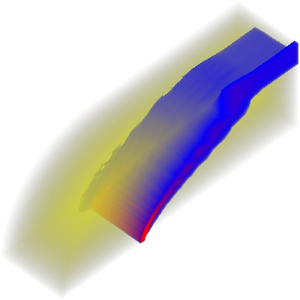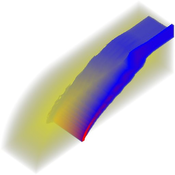Information
- Publication Type: Technical Report
- Workgroup(s)/Project(s):
- Date: April 2004
- Number: TR-186-2-04-07
- Keywords: Raycasting, Volume Rendering, Visibility Sorting, Curvilinear grids, Depth Sorting
Abstract
In this paper we present a novel hybrid CPU-GPU approach for rendering curvilinear grids. Visibility sorting is accomplished by parallel peeling cells off the grid, utilizing an active cell peeling front. In each step, we compute the ray-cell intersection coordinates on the GPU, perform accurate volume integration (CPU), and determine the set of active cells for the next iteration (GPU). The approach requires only standard graphics capabilities and can therefore be used on any commodity PC, including laptops. Furthermore, the main memory requirements are negligible since the required data structures are minimal. The main advantage of our algorithm is that we exploit hardware acceleration for the expensive visibility sorting which is bene- ficial over time due to the faster performance increase of GPUs over CPUs. Due to the simplicity of the algorithm and its low requirements on preprocessing and main memory, it is well suited for thin clients. Last but not least, the approach could easily be extended to irregular grids using tetrahedra.Additional Files and Images
Weblinks
No further information available.BibTeX
@techreport{GRIMM-2004-PPC,
title = "Parallel Peeling of Curvilinear Grids",
author = "S\"{o}ren Grimm and Michael Meissner and Armin Kanitsar and
Eduard Gr\"{o}ller",
year = "2004",
abstract = "In this paper we present a novel hybrid CPU-GPU approach for
rendering curvilinear grids. Visibility sorting is
accomplished by parallel peeling cells off the grid,
utilizing an active cell peeling front. In each step, we
compute the ray-cell intersection coordinates on the GPU,
perform accurate volume integration (CPU), and determine the
set of active cells for the next iteration (GPU). The
approach requires only standard graphics capabilities and
can therefore be used on any commodity PC, including
laptops. Furthermore, the main memory requirements are
negligible since the required data structures are minimal.
The main advantage of our algorithm is that we exploit
hardware acceleration for the expensive visibility sorting
which is bene- ficial over time due to the faster
performance increase of GPUs over CPUs. Due to the
simplicity of the algorithm and its low requirements on
preprocessing and main memory, it is well suited for thin
clients. Last but not least, the approach could easily be
extended to irregular grids using tetrahedra.",
month = apr,
number = "TR-186-2-04-07",
address = "Favoritenstrasse 9-11/E193-02, A-1040 Vienna, Austria",
institution = "Institute of Computer Graphics and Algorithms, Vienna
University of Technology ",
note = "human contact: technical-report@cg.tuwien.ac.at",
keywords = "Raycasting, Volume Rendering, Visibility Sorting,
Curvilinear grids, Depth Sorting",
URL = "https://www.cg.tuwien.ac.at/research/publications/2004/GRIMM-2004-PPC/",
}


 Paper
Paper
